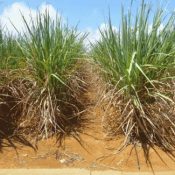
May 31, 2018 Ryukyu Shimpo
By Junko Uechi
Despite beginning its rainy season on May 8, the Okinawa region continues to see very little rain. There was only one day in which it rained heavily on the south-central part of the main island of Okinawa, and that was on May 21. Due to the effects of a dry rainy season that has lasted more than three weeks, the quantity of water in the dams has fallen below 27.1 units compared to regular years. In other words, it has decreased to 47.1 percent. On remote islands, since precipitation is significantly lower than regular years, it is greatly affecting the growth of crops, such as sugarcane. Some villages are considering rationing water. People from the tourist industry are also voicing their concerns about water shortage with the summer tourist season just around the corner.
Minamidaito, Tokashiki, and Zamami Villages continue to see very little rain even after entering the rainy season. The lack of rain has affected agriculture and daily life water supplies. With the expected increase in tourism ahead, some villages are contemplating rationing water.
April’s precipitation for Minamidaito Village was 13.0 millimeters, and as of May 29, May’s precipitation was 18.5 millimeters, making it the remote island near the main island with the lowest rainfall. As of May 25, the storage percentage of the 18 reservoir locations on the island was 28.2. Sugarcane are already in the midst of dying. The village’s Sugarcane Production Cooperative head Tsutomu Gima, 61, depressedly said, “The important period for sugarcane growth is between March and June.”
April’s precipitation for Kitadaito Village was at a historic low at 14.5 millimeters. As of May 29, May’s precipitation remained at about 30 millimeters. According to a village representative, on average, the water reservoir for agriculture has decreased to about 50 percent. The storage percentage of the reservoir in Kurobe area on the west side of the island is down to 10 percent. Katsuya Uechi, 57, said, “The yield will probably drop by about 50 percent. We’ll just have to wait for heavy rains or a typhoon.”
As of May 30, the storage percentage of the Zamami Dam in Zamami Village was 43.93 percent and 31.1 percent for Utaha Dam of Aka Island. While Zamami Island has a seawater desalination facility and Aka Island has a seawater desalination apparatus, since the number of tourists will increase starting late June, a village representative said, “We have no choice but to contemplate rationing water starting now.”
Even in Tokashiki Village, as of May 30, the storage percentage was below 36 percent. Normally, it is at about 80 percent, so there is a high probability that the village will take the plunge and ration water. While Aguni and Tonaki Villages are also witnessing less rain than normal years, according to representatives from both villages, they both have had a certain amount of precipitation where it is not significantly affecting agriculture and daily life water supplies.
Meanwhile, according to the Okinawa Meteorological Observatory, the seasonal rain front is advancing southward. According to the forecast, up to June 3, the main island of Okinawa area will be cloudy with intermittent rain. Up to June 4, Kitadaitou, Minamidaitou, Miyako, and Yaeyama areas are expected to be cloudy with occasional rain.
(English translation by T&CT and Chelsea Ashimine)
Go to Japanese
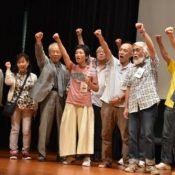
May 28, 2018 Ryukyu Shimpo
The nationwide liaison council Opposition to Soil Hauling, which is comprised of 18 organizations from 12 prefectures containing sites from which soil is being harvested for land reclamation use in Henoko, held a prefectural rally on May 27 at the Okinawa City Civic Center protesting land reclamation work and the building of a new base in the ocean.
Okinawa and the prefectures from which soil is being harvested have come together and adopted a resolution requesting that soil not be transported for land reclamation in Henoko.
As it seems that the government may be dumping in July, the rally drew the participation of 220 people from both within and outside of Okinawa.
Representatives of eight organizations from places where soil is being harvested (including Kagawa, Kagoshima, Yamaguchi, and Kumamoto) took the podium and reported on their efforts against soil hauling.
One speaker reaffirmed opposition to the new base with the words: “I will not let even one grain of sand from my hometown be used for war.”
On behalf of Okinawa, on May 29 the liaison council will call for cooperation from the prefectures in which soil is being harvested.
An advisor to the liaison council, Ichiro Yuasa, pointed out the risk of invasive species being brought from outside Okinawa and destroying Okinawa’s natural ecosystem.
He called for advancement of the movement with keywords such as “biodiversity,” and “non-military.”
Executive committee member Riki Moromi of the National Federation of Dockworkers Unions of Japan also took the podium and said, “From the standpoint of laborers who work in the harbors, it is unacceptable to be expected to do soil transportation work for base construction in Henoko.”
(English translation by T&CT and Erin Jones)
Go to Japanese
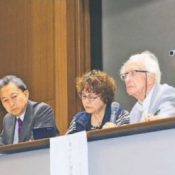
May 27, 2018 Ryukyu Shimpo
Tokyo – Aoyama Gakuin University Center for International Studies hosted a symposium titled, “How to make peace in East Asia?” at the Aoyama Gakuin campus in Tokyo May 25.
Peace-studies expert Johan Galtung and former prime minister Yukio Hatoyama attended the panel.
Galtung proposed the idea that Japan was in need of a “Japanese Restoration,” based on the spirit of the Meiji Restoration that transformed the structure of Japan 150 years ago.
Galtung also commented that the disputed Senkaku islands, “could become the place to actively put peace into practice,” reprising his proposition that the disputed territory be co-administered by Japan and China as a way to avoid friction.
He also stressed the necessity of forging and East Asian community as a practical strategy for avoiding war, elaborating, “I continue to propose that Okinawa could function as the central hub of this community, as it has a unique perspective.”
Additionally, he indicated that there should be thought given to reconciling historical wounds suffered by Okinawa such as the forced annexation by Japan in 1879.
Regarding the avoidance of war, Galtung said, “Nations that employ warfare as a problem-solving policy are becoming fewer and fewer.
I want to tell the Abe administration that his methods are outdated.” He also indicated the global influential power of the United States was waning.
He warned that Japan should not follow in their footsteps.
Former Prime Minister Hatoyama emphasized, “It is being said that the threat posed by North Korea is fairly exaggerated.
What is needed now is a strategy that will build peace through dialogue.”
The discussion was also paneled by Professor Akira Kimura from Kagoshima University and Professor Kumiko Haba from Aoyama Gakuin University.
(English translation by T&CT and Sam Grieb)
Go to Japanese

May 23, 2018 Ryukyu Shimpo
On May 23, Governor Takeshi Onaga gave the Okinawa Prefectural People’s Honor Award to 40-year-old Namie Amuro, a singer from Okinawa who plans to retire in September.
At the award ceremony at the Okinawa Prefectural Office, Governor Takeshi Onaga said, “Your brilliant success gave the Okinawan people big dreams and inspiration,” and praised her achievement as a “diva of Heisei” who made a number of records at the forefront of the music world.
Amuro wiped away tears and thanked him with a catch in her throat: “I am glad to receive such an honorable award. Thank you very much.”
Amuro is the sixth person to whom the Prefectural Government awarded the Prefectural People’s Honor Award. In order to avoid the chaos of a rush of visitors, the decisions about the award were not made public in advance, and the award ceremony was held in private.
Governor Onaga, who continues medical treatment after pancreatic cancer surgery, appeared publicly for the first time in a week to present the Honor Award. Onaga said, “I still clearly remember her singing proudly in front of world leaders as a representative artist of Japan at the Kyushu-Okinawa Summit in 2000.
As an Okinawan citizen, I was very proud.” Along with the award, Onaga presented Amuno with gifts of jewelry such as an Okinawan ring and a hairpin (jifa).
After the ceremony, Amuro answered questions from reporters and said, “In my 25 years of activity since my debut, if I made many people smile and gave them energy, then I feel glad that I worked hard.”
Amuro, who learned singing and dancing at the Okinawa Actors School, made her national debut in 1992 as a member of the five-member all-female group the Super Monkeys.
After switching over to solo activities, she released hit songs such as Can You Celebrate? and flourished as a singer representing Japan and Asia.
She also sparked the “Amura” phenomenon, in which women imitated her fashion for a significant period of time.
In September last year she announced her intention to retire from her singing career in one year’s time, and now she is finishing out a national dome tour and an Asia tour as the last year of her work.
The Prefectural People’s Honor Award was founded in 1999.
Those awarded the honor up to this point were the Okinawa Shogaku High School Baseball Club (the first winner from Okinawa in the spring Koshien in 1999), Hirokazu Ueyonahara (the 2008 Beijing Paralympic male wheelchair marathon silver medalist), the Konan High School Baseball Club (the 2010 winners in the spring and summer Koshien), Ai Miyazato (2010, the Japanese golfer with the most wins in the Ladies Professional Golf Association Tour), and Susumu Nakazato (2016, Rio Paralympic wheelchair rugby bronze medalist).
(English translation by T&CT and Megumi Chibana)
Go to Japanese
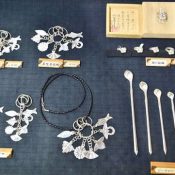
May 23, 2018 Ryukyu Shimpo (originally published on January 4, 2014)
By Kenichi Yoshida
On May 23, the Okinawa Prefecture bestowed the Prefectural Honor Award to singer Namie Amuro.
Besides a certificate of commendation, Okinawan handcrafted jewelry in the form of a fusa ring (traditional Okinawan ring) and a jifa (hairpin) were sent as souvenirs.
Exactly what are these and what sort of history do they have? Here we introduce an article on a craftsman who revived handcrafted Okinawan golden work.
“Ding, ding, ding” — The clanging of a hammer that has sounded since the Ryukyu Dynasty Era echoes throughout a workshop of just a little over 10 tatami mats (about 18.2 square-meters). Kenjiro Matayoshi, age 83, is the seventh owner of Kuganize~ku (goldsmithery) Matayoshi, a workshop in Ishimine Town of Shuri, Naha City.
He is also the only goldsmith in Okinawa that continues to create jifas and fusa rings.
A dignified Ryukyu woman stands with a jifa in her hair. A fusa ring’s seven charms that jingle.
A knot ring that etches two strings crisscrossing. All of which are elegant and charming.
The history of Okinawan goldsmithery goes back about 500 years.
During the Ryukyu Dynasty Era, many craftsmen had created all sorts of artwork.
However, due to the Battle of Okinawa, many tools and creations were lost and the history of goldsmithery disappeared from the center stage.
The one who had revived the artform was Kenjiro’s father and sixth owner, Seiboku.
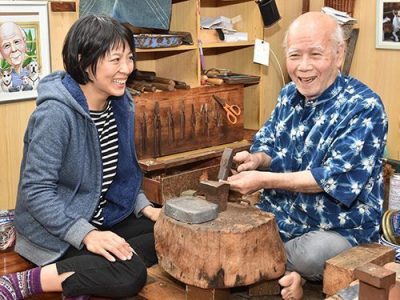
Kenjiro Matayoshi, who followed his father’s footsteps and continues to create golden work, along with Natsuko Miyagi, who’s in her seventh year of apprenticeship on December 29, 2013 at Kuganize~ku Matayoshi in Ishimine Town of Shuri, Naha City.
As the fires of war grew more intense, Seiboku had grabbed several of his tools and left home, assuming Naha too would be hit by an airstrike one day.
Seiboku had left the workshop in Izumizaki, Naha City to Tomari, Tomari to Kinjo-cho of Shuri, then to Oku of Kunigami barely escaping with his life, but managed to protect the tools that were passed down from previous generations.
Tools that were left behind at the workshop were also retrieved after the war from what was left of the workshop, which was in burnt ruins.
Those tools today have been passed on to Kenjiro, who continues to create the same golden work his father used to make.
Kenjiro chisels in the same posture and rhythm as his father.
He said, “My father had mentioned that without proper feeling and posture, it would not take proper shape.”
Kenjiro said that there is no need for originality in goldsmithery.
Pursuing simplicity in the traditional form is how it has always been and should be.
He has even let go of apprentices that sought originality.
In the past, Kenjiro had worked for a radio station, but decided to become Seiboku’s apprentice at age 40 after wanting to “create something that will remain in time.”
Even now, he says that he “hasn’t reached his father’s skill level” and continues to devote himself every day to craftsmanship by taking the tools in hand his father has left him.Meanwhile, there are obstacles in passing down the craftmanship.One of which is a lack of successors. Right now, Kenjiro has three apprentices, but hopes to “pass down the technique to many people.”
Will the Okinawan technique that creates traditional beauty be passed on? In the meantime, Kenjiro will look to the future while continuing to chisel away, silently.
(English translation by T&CT and Chelsea Ashimine)
Go to Japanese
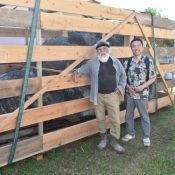
May 23, 2018 Ryukyu Shimpo
On May 22, the sculpture Kaiho he no Ogari, which had been installed on the wall of the Sumiyoshi North Citizens’ Cultural Exchange Center in Sumiyoshi Ward, Osaka City, was sent back to its sculptor, Minoru Kinjo.
Kinjo had completed the work in February 1977 while corresponding with residents of Sumiyoshi.
When residents heard that the Center was going to be demolished, they reported the information to Kinjo.
The relief is 12.3 meters tall, 7 meters wide, and weighs over 3 tons.
It was divided into 8 parts for transportation.
It is the largest work that Kinjo ever made. In March 2016 the Center was closed due to Osaka City having economic difficulties.
Demolition work is planned to start in June this year.
Sumiyoshi residents commissioned the sculpture from Kinjo, which was installed as a symbol of Sumiyoshi Ward amidst the Buraku Liberation Movement.
Ogari is a word from Sumiyoshi meaning “to cry out.”

Kaiho he no Ogari installed on the Sumiyoshi North Citizens’ Cultural Exchange Center building (photograph provided by the Sumiyoshi Branch of the Buraku Liberation League’s Osaka Association)
In Kinjo’s early childhood he was barred from playing with a close friend of his who had leprosy, and later on when he worked as a teacher in Osaka he was in contact with Koreans residing in Japan and people from the burakumin areas.
He emphatically pronounced: “People stood with the liberation movement against discrimination. That was wonderful. However, there are still issues such as hate speech. This country is uninterested in human rights.”
He went on to mention that, “I hope this statue becomes a symbol invoking thought on human rights issues.”
Kengo Tomonaga, head of the Sumiyoshi Branch of the Buraku Liberation League’s Osaka Association, said, “This could become a symbolic bridge linking the issues of the burakumin areas and Okinawa’s military base issues.”
Sumiyoshi Ward residents and concerned persons have been conducting fund raising with a goal of 8 million yen to relocate the sculpture to Okinawa.
(English translation by T&CT and Erin Jones)
Go to Japanese
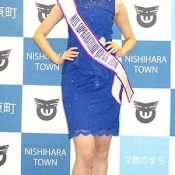
May 15, 2018 Ryukyu Shimpo
Twenty-three-year-old Yurika Nakamoto from Onaha, Nishihara in Okinawa, was selected to represent Japan in the international beauty pageant called Miss Supranational, which will be held in Poland in December.
Nakamoto visited Mayor Akira Uema at the Nishihara town office, commenting,
“I would like to work on my English skill and culture for the upcoming international competition.”
Nakamoto was born in 1995, and she started playing volleyball when she was in Nishihara Higashi Elementary School.
She also played during her time in Koza High School as an expert attacker, and the team ranked amongst the best at the Okinawa Prefectural Tournament, and even competed in national competitions.
Nakamoto continued playing volleyball at Nagasaki International University, where she also got a teacher’s license in health and physical education.
Nakamoto learned about the calls for Miss Supranational Japan candidates on TV and decided to take the chance.
The Miss Supranational Japan competition was held at the TOKYO FM Hall on May 6, where her long limbs, shapely figure, honest character and Q&A session answers were highly received.
The photographer at the stage also commented, “She possesses undiscovered potential.” She also received the Top Model Award.
Nakamoto is 174 centimeters tall, and her young brother, Kenyu Nakamoto, in the all-Japan national junior volleyball team.
She currently works as a model and coaching volleyball at her hometown high school.
Nakamoto comments, “I would like to become an international model and athletic coach,” as she promises a great performance on the international stage.
(English translation by T&CT and Sayaka Sakuma)
Go to Japanese
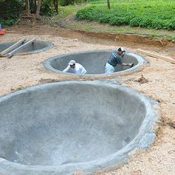
May 15, 2018 Ryukyu Shimpo
By Maki Nagamine
Mikito Ikehara, an indigo dye artist from Izumi, Motobu Town who handles the refining of Ryukyu indigo, has begun practicing a traditional dyeing process by using pots presumably made before the war.
Three indigo pots that have been buried in the ground for at least 50 years were dug out in April this year.
Ikehara plans to start using them in the summer. He has been working with Ryukyu indigo for ten years.
He said, “I want to master these techniques and inherit traditional skills.”
An indigo pot is used to mix water and the Ryukyuai (Ryukyu indigo) leaves, and to extract pigment.
In the Izumi area, where indigo dye making was popular before the war, there were many indigo pots.
The three pots Ikehara dug out recently were in his Ryukyuai field in the mountain area of Izumi.
In the fall of 2016, Ikehara was looking for land to cultivate and found indigo pots buried in the ground.
He thought, “I want to make indigo dye with these,” and rented the land.
All of the pots are in the shape of bowls, in which plants and water are easy to mix.
They are each 3 meters in diameter and 1.3 to 1.4 meters in depth, with the capacity to hold about 4 tons of water.
After accumulated soils were removed from the pots, it was found that the bottoms were made of plaster, and there were traces of concrete used to repair the walls.
Yukari Owan, a curator at the Okinawa Prefectural Museum, said, “I think the indigo pots were made before the war.”
On April 4, Ikehara and his two friends from Izumi repaired the deteriorated walls.
Masanobu Teruya, who is a construction worker, said, “[Ikehara] does interesting things.” Ikehara thanked him and replied, “It’s because I have help from my local elders.”
Ikehara now manages three indigo fields and handles indigo dyeing and indigo mud making in his studio in Izumi.
He said that his number one reason for using the indigo pots made and used a long time ago is because he is curious about them.
Meanwhile, he is also determined to be involved in traditional industries in Okinawa.
He said, “I do things myself and gain experience through my failures.
Because I am involved in traditional things, I want to master these techniques and inherit traditional skills.”
(English translation by T&CT and Megumi Chibana)
Go to Japanese
May 23, 2018 Ryukyu Shimpo
U.S. marines in Okinawa conducted training to drop vehicles and soldiers from an airplane at Ie airfield on Ie Island, Okinawa, on May 22.
According to Ie village, the dropped vehicles and soldiers landed on the airfield, and no damage has been reported on public land.
The village received a notification about the training from the Okinawa Defense Bureau (ODB) on May 17, to which the village government responded on May 18 with a request to cancel the training.
The U.S. military conducted the training despite the calls to cancel.
According to government officials, the vehicle drop training has not been done for ten years.
The village and the ODB confirm that the drop training was conducted between 10:30 a.m. and 11:30 a.m.
It was observed that one vehicle and nine soldiers dropped onto Ie Airfield over three times from an airplane which is thought to be a C-130.
Ie village mayor, Hideyuki Shimabukuro, stressed in an interview with Ryukyu Shimpo, “Basically, our thinking is that we would like them to avoid conducting drop training involving heavy material.”
The Okinawan prefectural government was notified about the training plan by the ODB. The prefecture demanded the ODB, “Work with the U.S. military to ensure the safety of the local residents, so that they suffer no fear or damage.”
According to analysis by Wataro Rai, an editor at the civil group called Rimpeace, which reports the activities of the U.S. military in Japan, the vehicle dropped from the aircraft was likely an MRZR, which is designed to drive on wasteland.
He further comments, “The training could be intended to imagine missions in dessert locations such as the Middle East. It is highly possible that the vehicle was retrieved by Osprey.”
According to Rai, MRZRs were deployed in Okinawa in 2017 and used in Camp Schwab as well as training centers in other prefectures.
In October of 2002, there was an accident in which three containers containing five-gallons of water, a total of sixty kilograms, dropped on a field outside of the training area.
There was also an accident in April of 2014 when four metallic barrels totaling 800 kilograms dropped from a U.S. military aircraft, landing outside of the fence of the training area.
Although the barrels landed inside military-controlled territory, the accident happened during the night and took place 90 meters away from a public road.
(English translation by T&CT and Sayaka Sakuma)
Go to Japanese
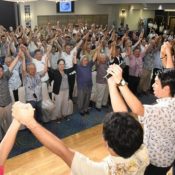
May 24, 2018 Ryukyu Shimpo
A signature gathering campaign was kicked off May 23 at the “Henoko Okinawan Resident Vote Assembly,” with the goal of putting a bylaw to Okinawan resident vote asking whether or not to allow the land reclamation project at Henoko, which is part of the relocation of MCAS Futenma.
That same evening, a kickoff meeting was held at Okinawa Kariyushi Urban Resort NAHA, attended by about 220 Naha residents in support of the initiative.
About 23,000 signatures, or 2% of eligible voters in Okinawa, are required to bring such a bylaw to a vote, however the assembly is aiming to collect around 115,000 signatures over the next two months.
In his greeting to the assembly, assembly advisor Morimasa Goya stressed the importance of the initiative, stating, “Since the return of Okinawa to Japan, have we truly obtained the human rights, peace, and democracy that we demanded?
This vote will demand that the U.S. military bases that have been stealing our land by bulldozer and bayonet, ‘finally give us a break.’”
Assembly representative Jinshiro Motoyama said, “I want this to further the discussion about things like World War II, the bases, and [Ryukyu] island’s shared problems,” and vice representative Nagatsugu Asato appealed, “I would like this vote to also serve as a chance to close Futenma, return the land, and send the base outside of the prefecture or even Japan.”
The participants at the assembly joined their hands together and said, “Let’s talk about the base. Let’s decide the future of Okinawa.”
(English translation by T&CT and Sam Grieb)
Go to Japanese

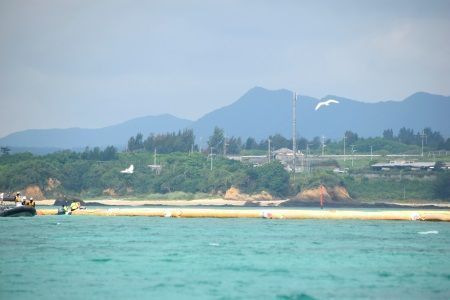











 Webcam(Kokusai Street)
Webcam(Kokusai Street)


